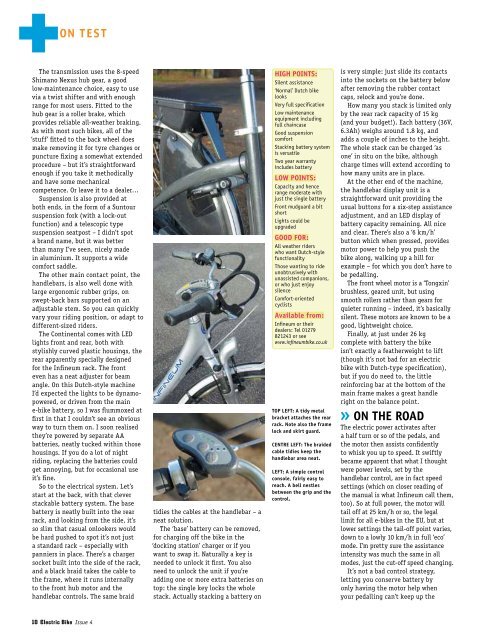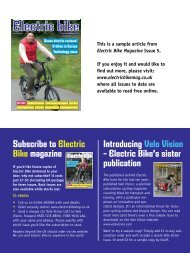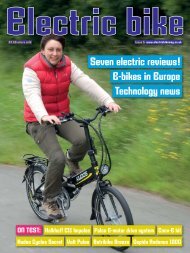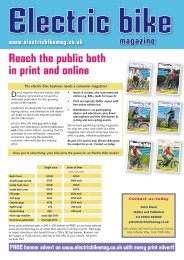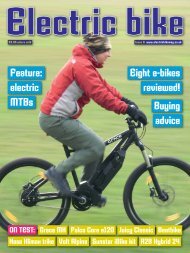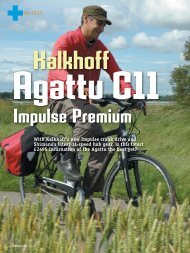Issue Four - Early 2012 - Electric Bike Magazine
Issue Four - Early 2012 - Electric Bike Magazine
Issue Four - Early 2012 - Electric Bike Magazine
You also want an ePaper? Increase the reach of your titles
YUMPU automatically turns print PDFs into web optimized ePapers that Google loves.
+ON TEST<br />
The transmission uses the 8-speed<br />
Shimano Nexus hub gear, a good<br />
low-maintenance choice, easy to use<br />
via a twist shifter and with enough<br />
range for most users. Fitted to the<br />
hub gear is a roller brake, which<br />
provides reliable all-weather braking.<br />
As with most such bikes, all of the<br />
‘stuff’ fitted to the back wheel does<br />
make removing it for tyre changes or<br />
puncture fixing a somewhat extended<br />
procedure – but it’s straightforward<br />
enough if you take it methodically<br />
and have some mechanical<br />
competence. Or leave it to a dealer…<br />
Suspension is also provided at<br />
both ends, in the form of a Suntour<br />
suspension fork (with a lock-out<br />
function) and a telescopic type<br />
suspension seatpost – I didn’t spot<br />
a brand name, but it was better<br />
than many I’ve seen, nicely made<br />
in aluminium. It supports a wide<br />
comfort saddle.<br />
The other main contact point, the<br />
handlebars, is also well done with<br />
large ergonomic rubber grips, on<br />
swept-back bars supported on an<br />
adjustable stem. So you can quickly<br />
vary your riding position, or adapt to<br />
different-sized riders.<br />
The Continental comes with LED<br />
lights front and rear, both with<br />
stylishly curved plastic housings, the<br />
rear apparently specially designed<br />
for the Infineum rack. The front<br />
even has a neat adjuster for beam<br />
angle. On this Dutch-style machine<br />
I’d expected the lights to be dynamopowered,<br />
or driven from the main<br />
e-bike battery, so I was flummoxed at<br />
first in that I couldn’t see an obvious<br />
way to turn them on. I soon realised<br />
they’re powered by separate AA<br />
batteries, neatly tucked within those<br />
housings. If you do a lot of night<br />
riding, replacing the batteries could<br />
get annoying, but for occasional use<br />
it’s fine.<br />
So to the electrical system. Let’s<br />
start at the back, with that clever<br />
stackable battery system. The base<br />
battery is neatly built into the rear<br />
rack, and looking from the side, it’s<br />
so slim that casual onlookers would<br />
be hard pushed to spot it’s not just<br />
a standard rack – especially with<br />
panniers in place. There’s a charger<br />
socket built into the side of the rack,<br />
and a black braid takes the cable to<br />
the frame, where it runs internally<br />
to the front hub motor and the<br />
handlebar controls. The same braid<br />
10 <strong>Electric</strong> <strong>Bike</strong> <strong>Issue</strong> 4<br />
tidies the cables at the handlebar – a<br />
neat solution.<br />
The ‘base’ battery can be removed,<br />
for charging off the bike in the<br />
‘docking station’ charger or if you<br />
want to swap it. Naturally a key is<br />
needed to unlock it first. You also<br />
need to unlock the unit if you’re<br />
adding one or more extra batteries on<br />
top: the single key locks the whole<br />
stack. Actually stacking a battery on<br />
HIGH POINTS:<br />
Silent assistance<br />
‘Normal’ Dutch bike<br />
looks<br />
Very full specification<br />
Low maintenance<br />
equipment including<br />
full chaincase<br />
Good suspension<br />
comfort<br />
Stacking battery system<br />
is versatile<br />
Two year warranty<br />
includes battery<br />
LOW POINTS:<br />
Capacity and hence<br />
range moderate with<br />
just the single battery<br />
Front mudguard a bit<br />
short<br />
Lights could be<br />
upgraded<br />
GOOD FOR:<br />
All weather riders<br />
who want Dutch-style<br />
functionality<br />
Those wanting to ride<br />
unobtrusively with<br />
unassisted companions,<br />
or who just enjoy<br />
silence<br />
Comfort-oriented<br />
cyclists<br />
Available from:<br />
Infineum or their<br />
dealers: Tel 01279<br />
821243 or see<br />
www.infineumbike.co.uk<br />
TOP LEFT: A tidy metal<br />
bracket attaches the rear<br />
rack. Note also the frame<br />
lock and skirt guard.<br />
CENTRE LEFT: The braided<br />
cable tidies keep the<br />
handlebar area neat.<br />
LEFT: A simple control<br />
console, fairly easy to<br />
reach. A bell nestles<br />
between the grip and the<br />
control.<br />
is very simple: just slide its contacts<br />
into the sockets on the battery below<br />
after removing the rubber contact<br />
caps, relock and you’re done.<br />
How many you stack is limited only<br />
by the rear rack capacity of 15 kg<br />
(and your budget!). Each battery (36V,<br />
6.3Ah) weighs around 1.8 kg, and<br />
adds a couple of inches to the height.<br />
The whole stack can be charged ‘as<br />
one’ in situ on the bike, although<br />
charge times will extend according to<br />
how many units are in place.<br />
At the other end of the machine,<br />
the handlebar display unit is a<br />
straightforward unit providing the<br />
usual buttons for a six-step assistance<br />
adjustment, and an LED display of<br />
battery capacity remaining. All nice<br />
and clear. There’s also a ‘6 km/h’<br />
button which when pressed, provides<br />
motor power to help you push the<br />
bike along, walking up a hill for<br />
example – for which you don’t have to<br />
be pedalling.<br />
The front wheel motor is a ‘Tongxin’<br />
brushless, geared unit, but using<br />
smooth rollers rather than gears for<br />
quieter running – indeed, it’s basically<br />
silent. These motors are known to be a<br />
good, lightweight choice.<br />
Finally, at just under 26 kg<br />
complete with battery the bike<br />
isn’t exactly a featherweight to lift<br />
(though it’s not bad for an electric<br />
bike with Dutch-type specification),<br />
but if you do need to, the little<br />
reinforcing bar at the bottom of the<br />
main frame makes a great handle<br />
right on the balance point.<br />
» ON THE ROAD<br />
The electric power activates after<br />
a half turn or so of the pedals, and<br />
the motor then assists confidently<br />
to whisk you up to speed. It swiftly<br />
became apparent that what I thought<br />
were power levels, set by the<br />
handlebar control, are in fact speed<br />
settings (which on closer reading of<br />
the manual is what Infineum call them,<br />
too). So at full power, the motor will<br />
tail off at 25 km/h or so, the legal<br />
limit for all e-bikes in the EU, but at<br />
lower settings the tail-off point varies,<br />
down to a lowly 10 km/h in full ‘eco’<br />
mode. I’m pretty sure the assistance<br />
intensity was much the same in all<br />
modes, just the cut-off speed changing.<br />
It’s not a bad control strategy,<br />
letting you conserve battery by<br />
only having the motor help when<br />
your pedalling can’t keep up the


